Thursday 27th June 2024
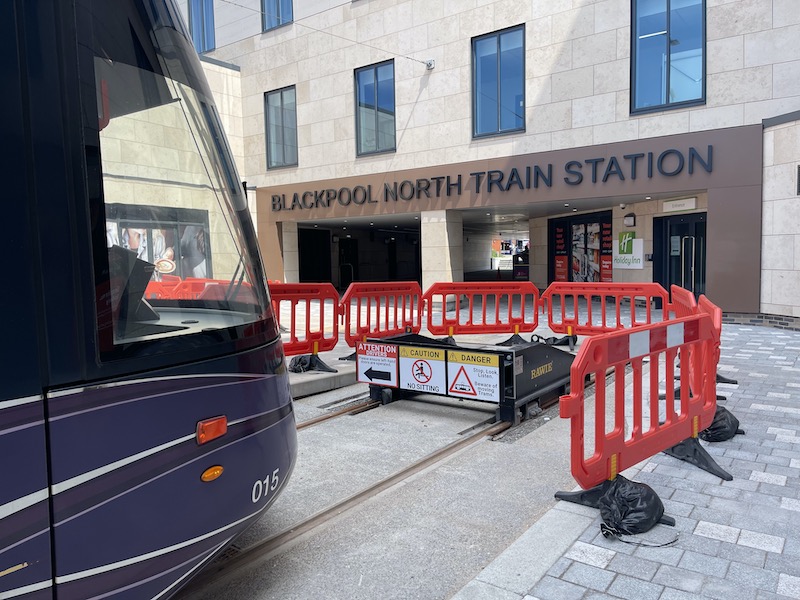
It was back in December 2017 Secretary of State for Transport, Chris Grayling (remember him?), gave the formal go-ahead for the £23.4 million Blackpool Tramway extension from North Pier along Talbot Road to Blackpool North railway station, enabling construction of the 600 yards of track to begin in April 2018 with a grand opening initially planned for July 2019.
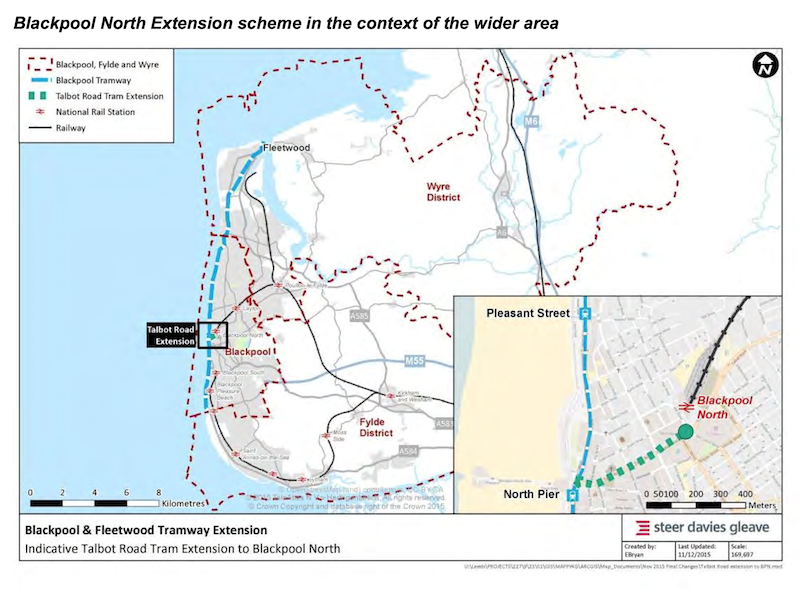
Five years later, the extension finally opened, on Sunday 16th June, restoring a direct link to the station from Fleetwood and Cleveleys, at the northern end of the line, as well as Starr Gate and the Pleasure Beach at the southern end, which last ran in 1936.
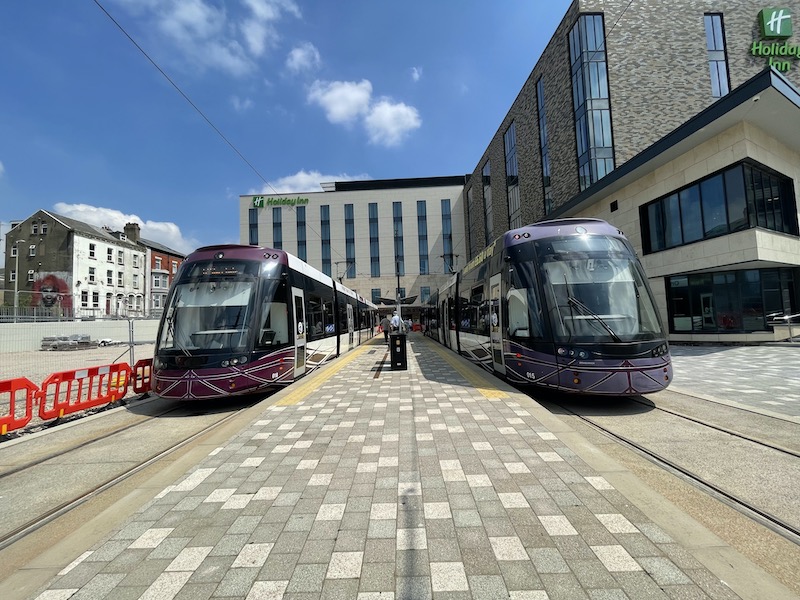
Lancashire Local Enterprise Partnership stumped up £16.4 million of the cost and granted the scheme ‘Conditional Approval’ in April 2016 but it took until November 2017 to sort those ‘Conditions’ out and the Full Business Case was given ‘Full approval’. Costs included the purchase of Wilko’s old retail store (where the new terminus and a new Holiday Inn Hotel now sit) as well as two additional trams to run the extended service, although in practice the frequency hasn’t proportionately improved, if anything it’s got worse in one respect, as we’ll see.
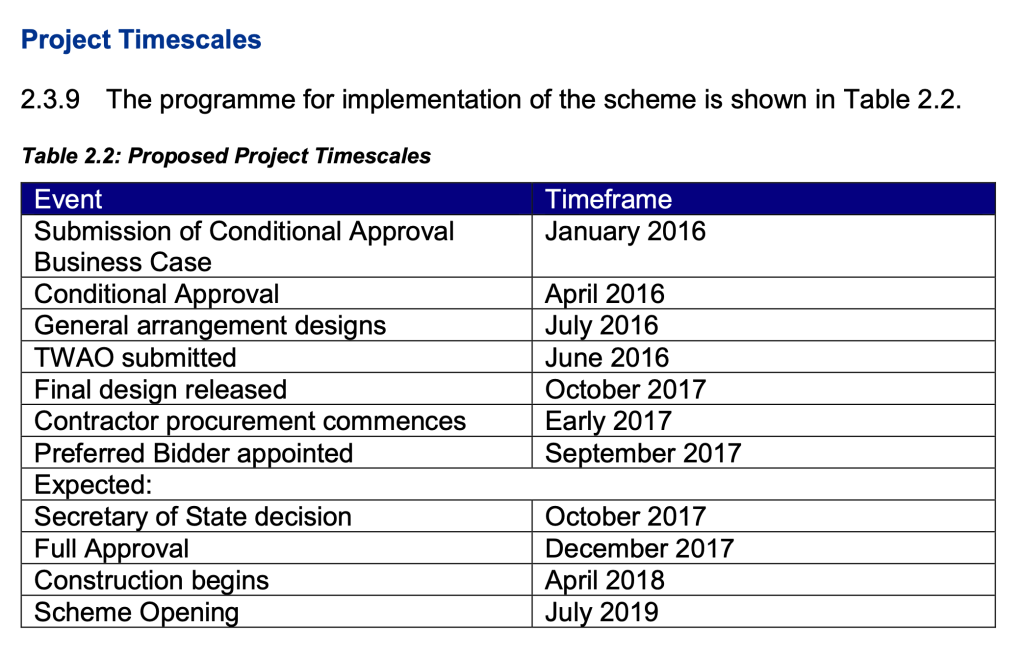
The £7 million funding balance came from Blackpool Council, including Private Sector Developer contributions. The Council also underwrote any overspend which, bearing in mind the five year delay, one would assume involves a significant sum, but the Council denies this, meaning the only financial penalty has been five years worth of lost revenue.

It’s reckoned the scheme has a Benefit to Cost Ratio of 3.07 representing ‘High Value for Money’. Operator revenue over the 60 year appraisal period is “nearly 33% higher than forecast operating costs” with the scheme generating “between 11,500 and 20,000 additional visitor trips to Blackpool per annum, generating between £29.5 million and £50.9 million Gross Value Added (GVA) benefits over the 60 year project appraisal period”.

So you can see the sums admirably added up for the Full Business Case, and even that pessimistic projection of 11,500 extra visitors over the next 60 years has got off to a flying start as I made it over to Blackpool yesterday to check out the new extension – a journey I wouldn’t have done had there been no extension, so that’s one in the bag for the Business Case target.
Trouble is, I took a packed lunch and thermos flask with me so I didn’t really add anything to Blackpool’s GVA. Still, the thought was there and I did pay the standard single fare of £3.50 for a two minute ride to the North Pier.
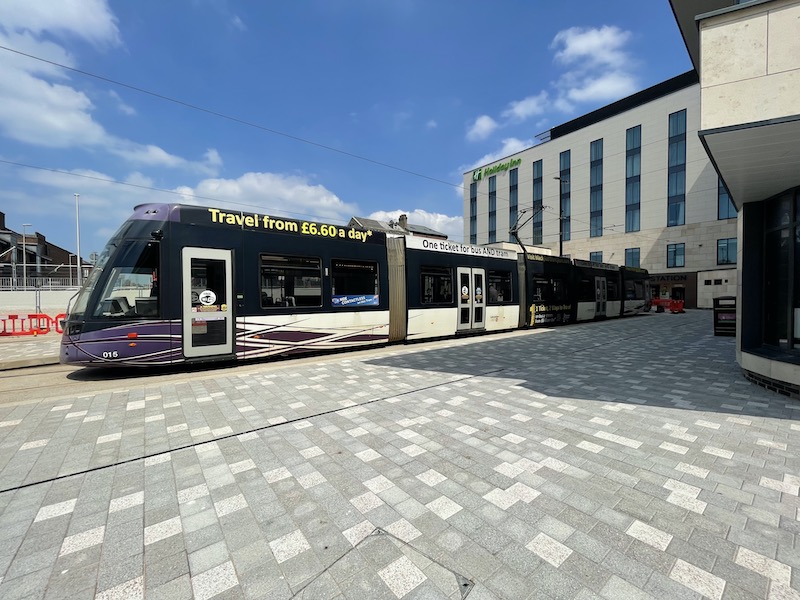
To explain the new operating pattern of service, Blackpool Transport has given the tram service three route numbers.
T1 represents the original service along the coast between Starr Gate and Fleetwood, which doesn’t divert to North Station.
T2 represents journeys from Starr Gate (in the south) to North Station, and T3 journeys from Fleetwood (in the north) to North Station.
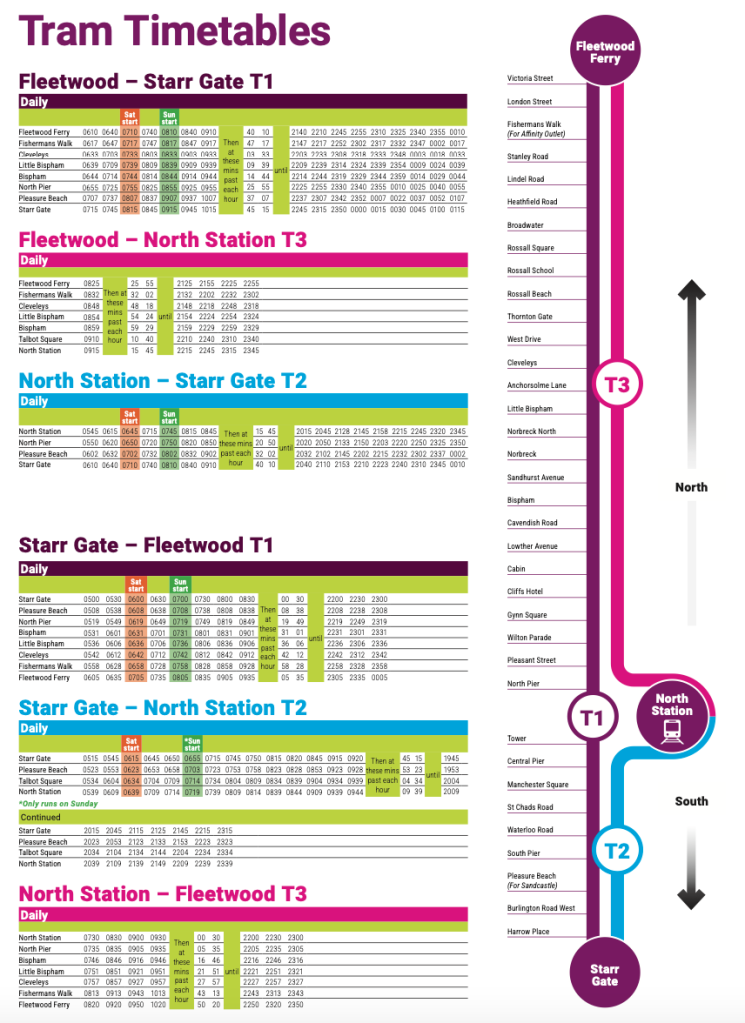
But, here’s the rub. Whereas the previous timetable had a 15 minute frequency on the T1, this is now reduced to every 30 minutes, supplemented by a 30 minute frequency on both the T2 and T3. So, it’s still four trams an hour along the coast, just that every other one no longer operates ‘through’ but instead diverts at North Pier/Talbot Square to North Station.
The unfortunate impact of the new timetable is the frequency of southbound journeys between Talbot Square/Tower and Starr Gate is no longer an even 15 minute frequency, as a T1 tram follows five minutes behind a T2 one, then leaving a 25 minute gap before the next T2.
It looks to me, whereas the previous timetable could be operated by 10 trams taking 150 minutes for a complete rounder including stand time at the termini, the new setup takes five trams for the T1, two for the T2 and four for the T3 making for an increase in just one tram rather than the two included in the Business Case. Perhaps that second tram was sacrificed for a post Covid cost saving and the uneven frequency?
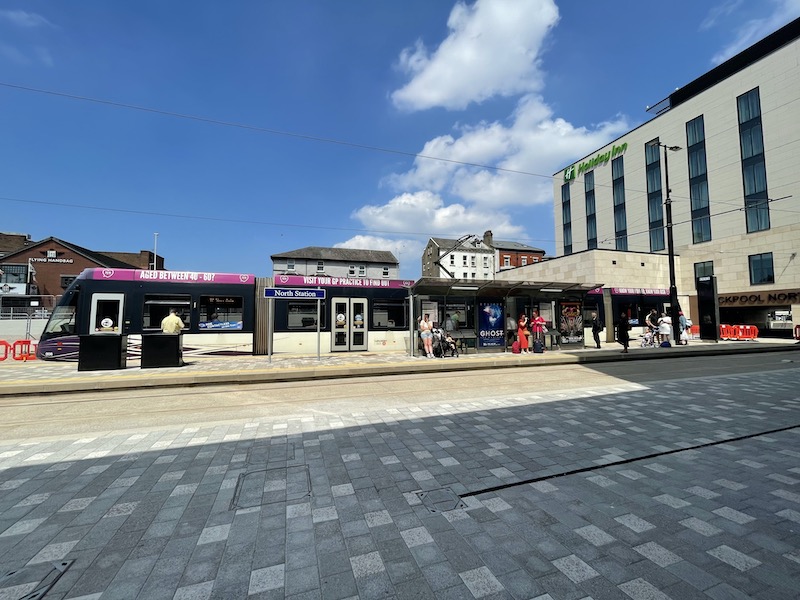
Mind you, it would make for a very inefficient schedule if it had been included. As it is, trams on the T3 sit for 15 minutes at North Station while the T2 is tighter with a six minute layover.
It should also be noted all other sections of the T1 route have an even 15 minute frequency with the T2/T3 offering a combined 15 minute frequency of trams leaving North Station, so in the grand scheme of things the 5-25-5-25 southbound frequency pattern is probably the least worst outcome.
I had a look around the new extension yesterday and it was interesting to see about a dozen passengers alighting and boarding most trams arriving and departing North Station indicating it’s got off to a good start.
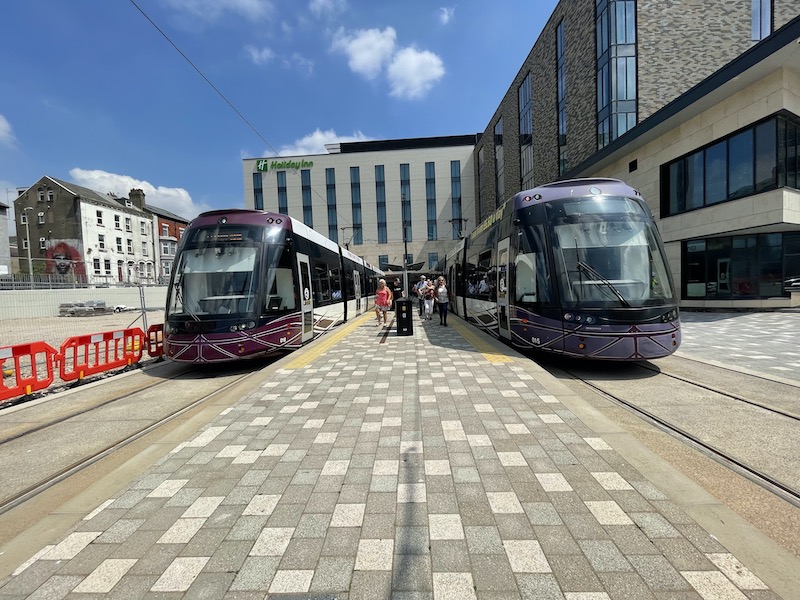
I was a bit surprised to see a proliferation of red and white barriers…
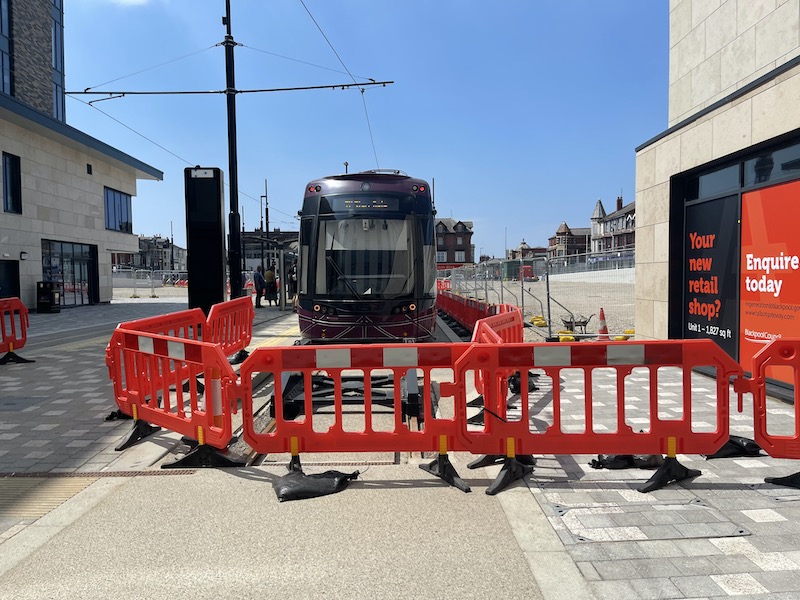
… all over the place indicating, despite the delayed opening by many years, work is still not complete.

The electronic departure signs on the island platform haven’t been activated so there’s no ‘real time’ departure information…
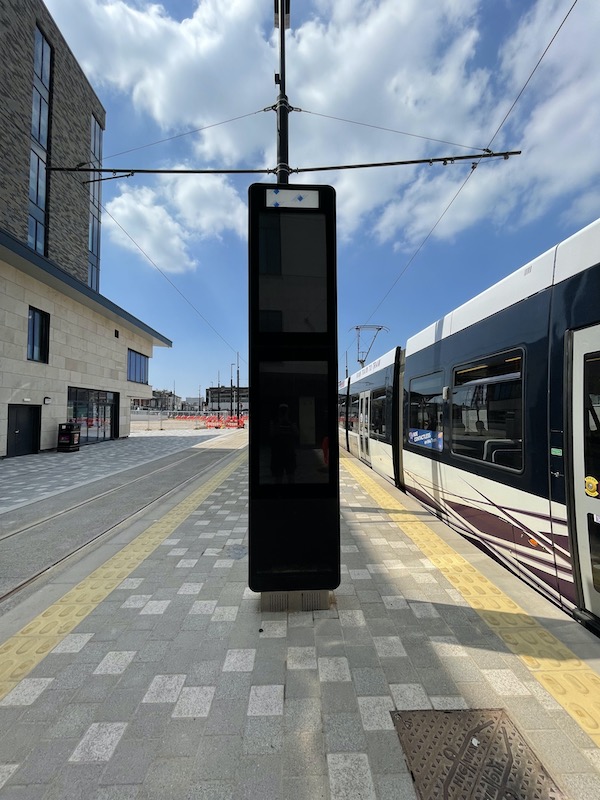
… but a couple of posters show timetables and a route diagram and tram conductors are on hand to help and advise.

The T3 tram arrives at the station from Fleetwood at 15 and 45 minutes past each hour just as the T2 leaves for Starr Gate so you could make a nifty cross platform interchange…
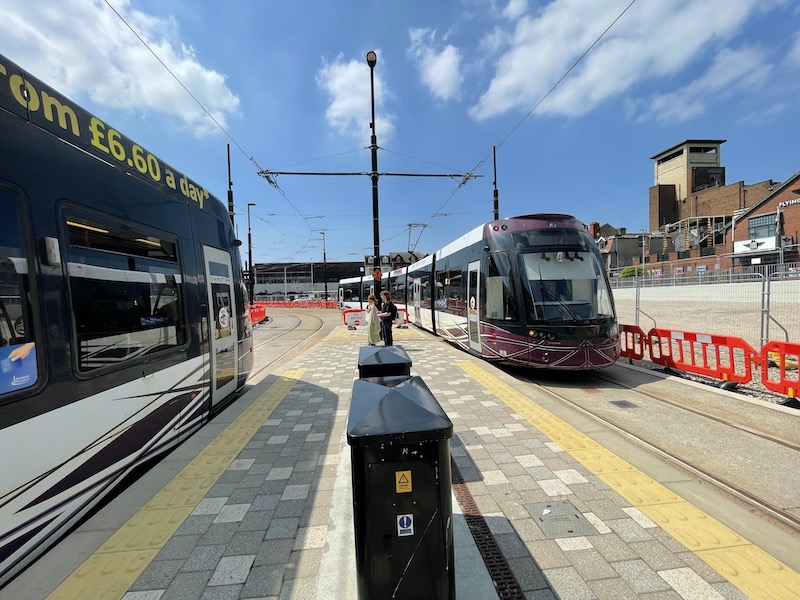
… although it makes more sense to alight at North Pier and walk the short distance to the Tower.
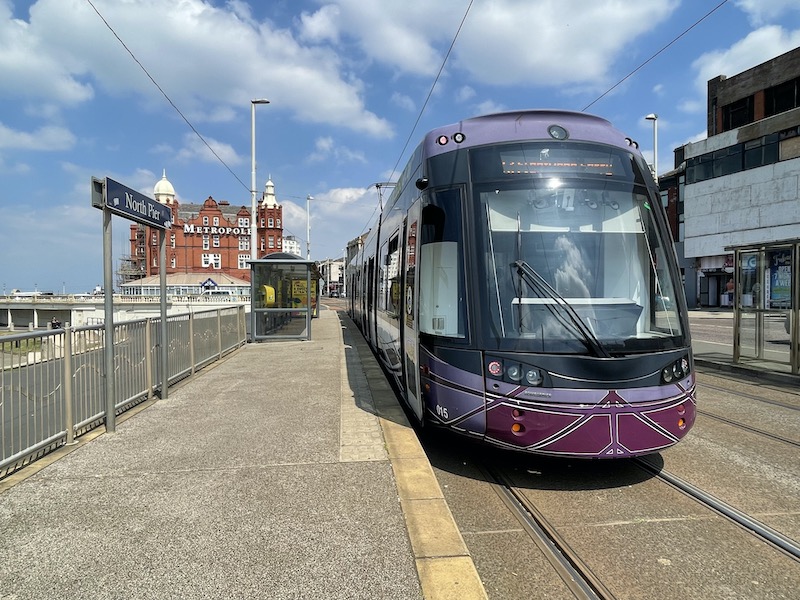
I caught a T3 tram from the station down Talbot Road to North Pier. Despite an errant motorist who thought nothing of blocking the tracks….
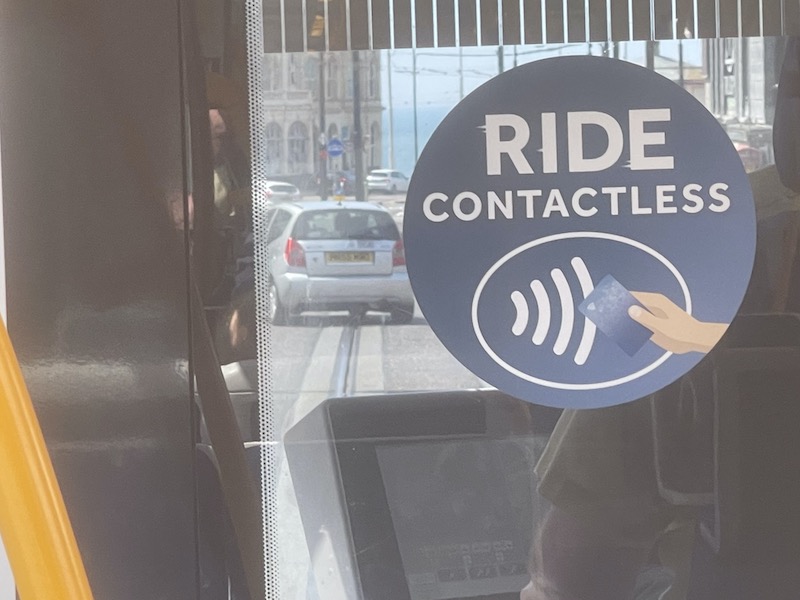
… which a quick blast of the tram horn soon made them move, it took just a couple of minutes as against four minutes running time given in the timetable.

Right on cue a T2 tram appeared from the south heading towards the station and most people alighted at the Talbot Square bus stop as well as a crew change.
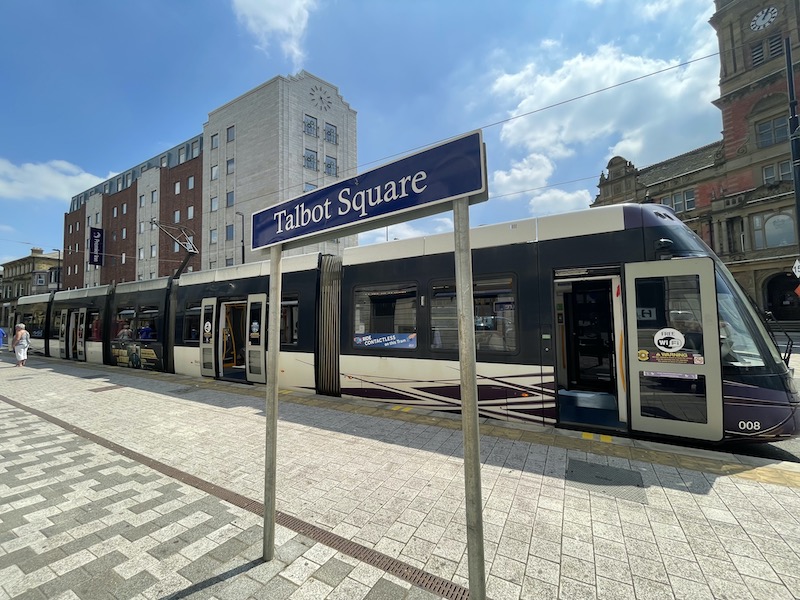
It’s been a long time coming but overall it looks like passengers are already appreciating the new interchange at the station…
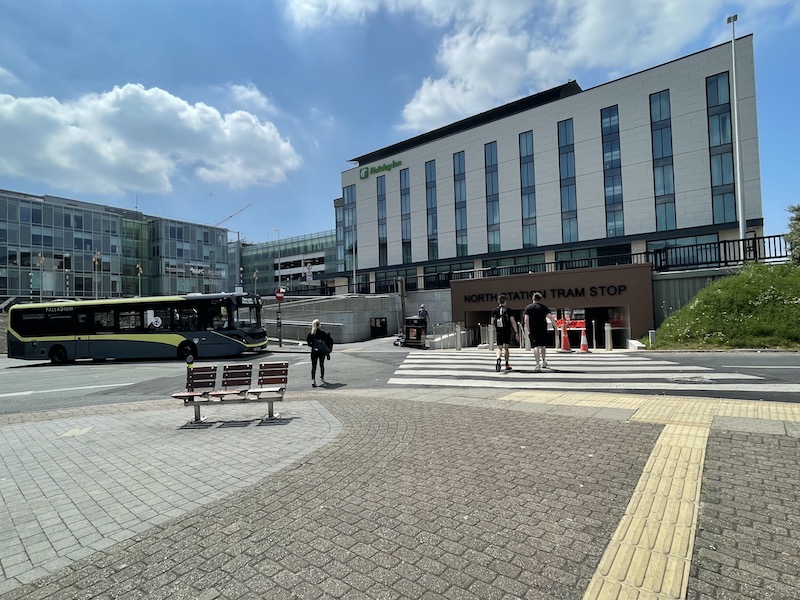
… with the tram island platform just a short walk through an enlarged underpass and under the hotel.
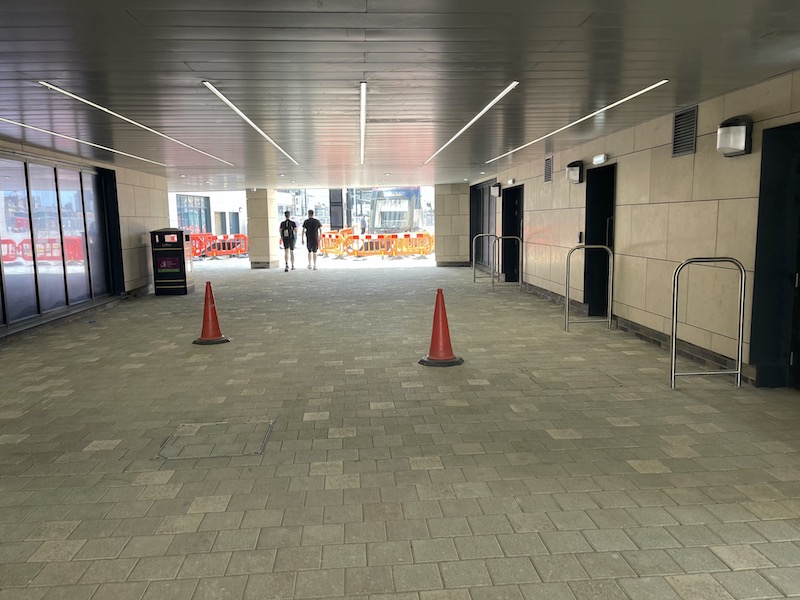
I see there’s scope for a couple of retail outlets there, but I’m not sure footfall will be large enough. It’ll be interesting to see if enterprising retailers take up the opportunities.
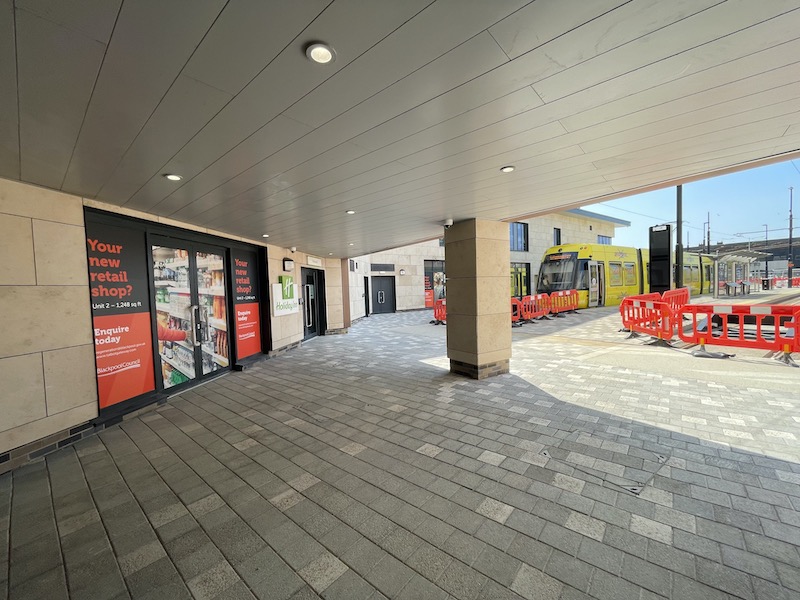
It’s not immediately clear where alighting passengers, not wanting the rail station, should go for the ‘Way Out’ from the new island platform. It could do with a sign to point to the steps alongside the hotel which are accessed from the opposite end of the platform to the rail station exit…
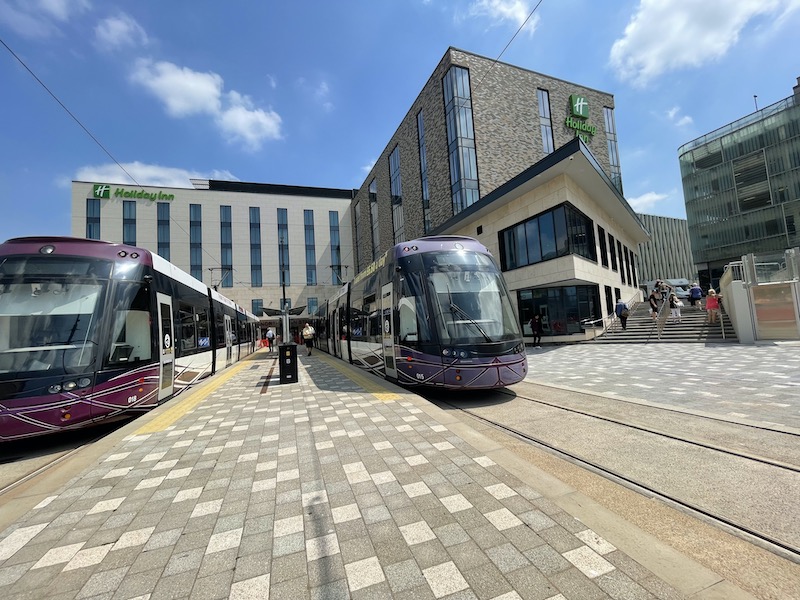
… especially as signs imply there’s no exit from where the trams have just arrived. Passengers understandably looked confused.
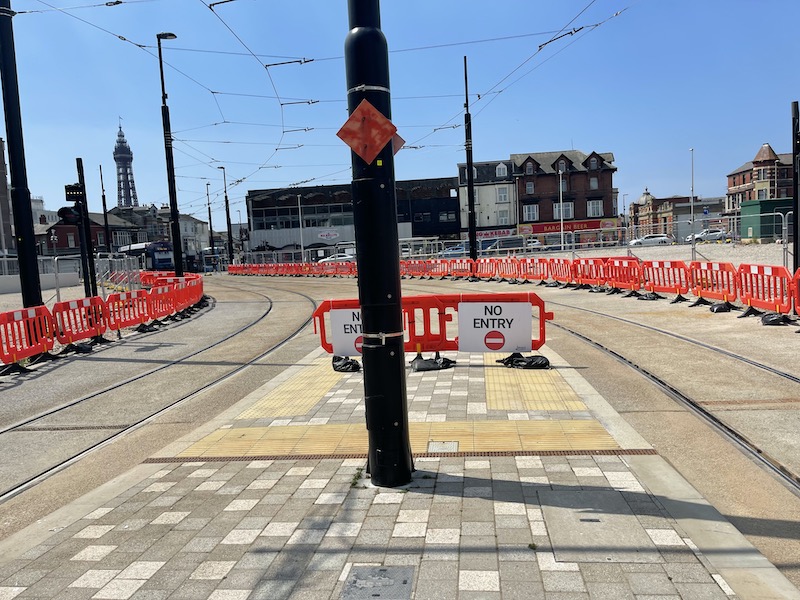
Perhaps it’s awaiting completion of the approach which may include pedestrian footpaths alongside the tracks?

I’m sure most residents and visitors will welcome the new extension now it’s finally opened. Most of the delays surrounded the demolition of the WIlko building (it didn’t commence until September 2020) as well as problems with the quality of paving including reports of “boot prints in asphalt, standing water and a pothole” as well as “technical problems with some of the cladding on the building” Local press reports say “senior councillors have met privately to dsicuss an ongoing dispute with the contractor”.
It was noteworthy on my visit yesterday despite all the barriers and unfinished work, no contractors were on site. It looked to me as though finishing work had been “paused”.
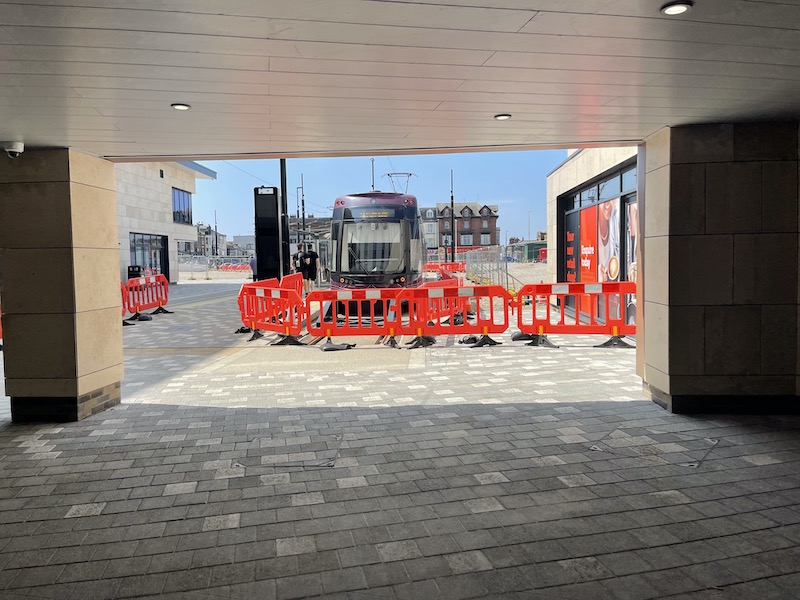
It’s interesting to look back on Chris Grayling’s letter of approval for the scheme in November 2017 where he lists some of the points made by objectors to what was called ‘BNE’ – Blackpool North Extension.
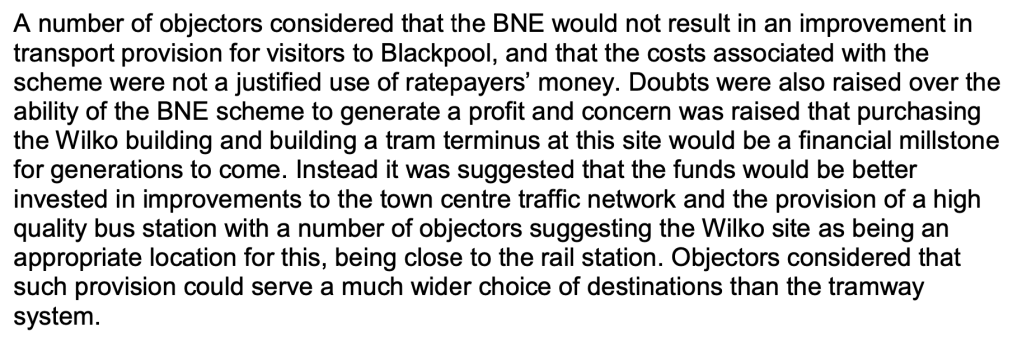
Blackpool Council’s consultants batted away these points with a robust repsonse.
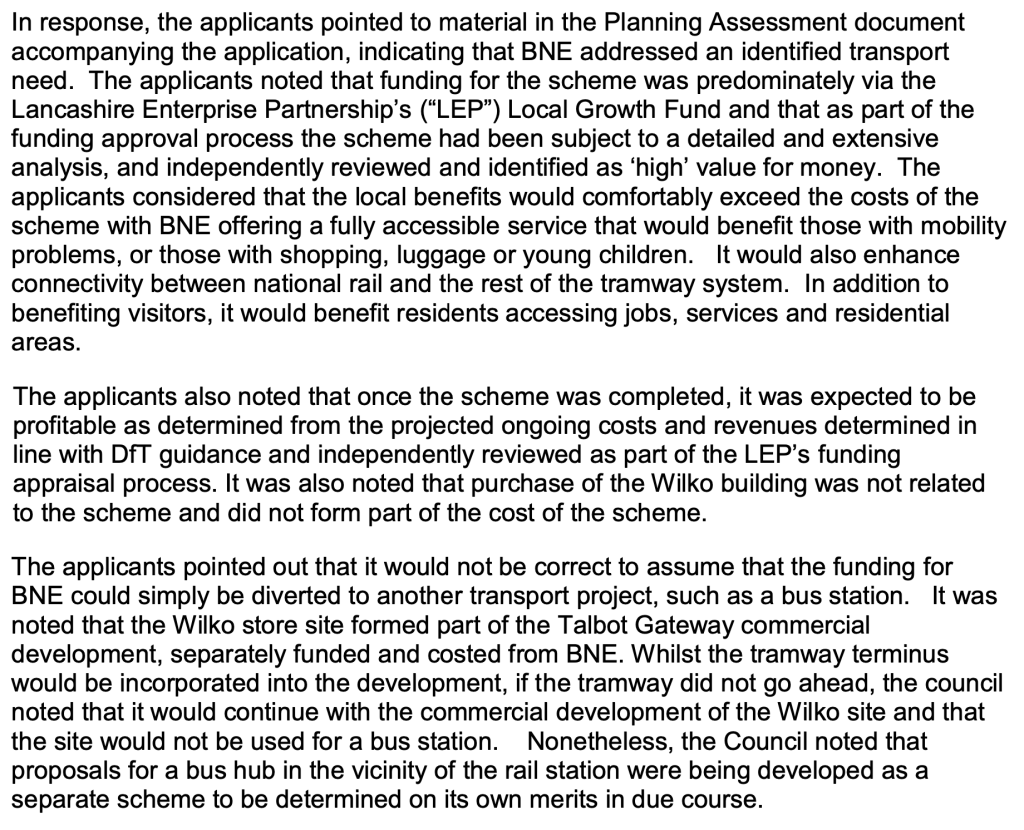

I’m sure the extension will prove itself over the next 60 years and the five year delay will soon be forgotten (just as with Crossrail/Elizabeth line) …. but the work needs to be finished and those barriers removed, ideally before the peak summer season when schools break up next month.
Roger French
Blogging timetable: 06:00 TThS with Summer Su extras.
Comments on today’s blog are welcome but please keep them relevant to the blog topic, avoid personal insults and add your name (or an identifier). Thank you.

The 30′ frequency on T2 and T3 is disappointing. If you arrive, say 20′ before the next T3 can you get a T2 and change onto a T3 on a cross-platform change once your T2 has turned onto the main promenade, and vice versa?
LikeLike
The 5/25 southbound headway North Pier to Starr Gate is appalling timetabling, giving a far worse service along the main 3 mile stretch of track than previously.
The business case assumed each route would run every 10 minutes so I wonder if all the “benefits” will be realised.
NEB
LikeLike
It is impossible to verify the true cost of the scheme
Whether the tram network is profitable is impossible to verify from the public accounts
12 passengers on that stretch of track though is not likely to even break even given the very high cost of operating trams
Are there any benefits to the extension Clearly there are but the benefits are not great and most of those journeys would probably have been made in any case but not by tram
Over 60 years I guess the cost is not much but that ignore the high operating and maintenance costs and the trams would need to be replaced at least once
LikeLike
“Over 60 years I guess the cost is not much but that ignore the high operating and maintenance costs and the trams would need to be replaced at least once”.
“”The most important thing is to understand whole-life costing. A tramway needs to be assessed over 40 to 50 years and in that period the biggest single expense will be staff costs, hence the need to achieve high ratios of passengers to drivers. Up to 300 people on a tram with a driver is better than 90 on a bus. Next highest cost will be vehicles and their maintenance. A tram will cost between £1M and £2.5M (over the 20- to 44-metre range of lengths in most manufacturers’ catalogues) but will last 35-40 years. A bus will cost £0.5M but last only 12-15 years. Maintaining buses is around twice as expensive as for trams, even allowing for OHLE costs. Take carrying capacity into account and anyone can do the maths. Crudely, a line requiring 10 x 30-metre trams at £1.5M a pop would need 30 buses replaced twice over the whole-life costing period. That’s why there are so many tram systems “over there” – Andrew Braddock”
https://bathtrams.uk/solving-baths-traffic/comparative-benefits-trams-vs-buses/
Peter Brown
LikeLiked by 1 person
Not really true, The capital cost of trams is very high, Full maintenance costs are high that the tram , overhead line and track as is the cost of the power. Labour cost can be a bit lower
LikeLike
This is just fantasy economics. “Who is paying” isn’t exactly a minor consideration as we have the highest tax levels for 70 years, and a stagnant and unproductive economy.
Most bus services in the UK are run commercially i.e at no cost to the taxpayer. This is very far from being the case with rail based modes. Yes trams, CAN (but certainly not have to) have social and even long term urban economy and planning benefits. However this is rather unlikely to be the case with such an infrequent service.
LikeLike
| Most bus services in the UK are run commercially i.e at no cost to the taxpayer.
The £2 fare means that every bus you see in England which is part of the scheme is operating at a cost to the taxpayer.
Add things like BSOG (and its predecessors) which are funded by the taxpayer, and the fact is that very few (if any) bus services in the UK are entirely commercial and receive no taxpayer support in any form.
A. Nony Mouse
LikeLiked by 1 person
Old trams may have lasted 50 years but new ones will not, You are looking at 15 to 25 years. Buses are typically kept for 10 years but can last for up to 20 years
LikeLike
Is the strange frequency towards Starr Gate a sign of a “soft launch”?? Perhaps the frequencies will be tidied up after this summer, when run times have been proved?
Although, perhaps some judicious 12/18/12/18 frequencies in places might have improved the initial timetables??
LikeLike
It would be more correct to say that trams have “almost” reached North station.
Anywhere else in Europe the track would continue through the underpass (and the hotel designed to accommodate that) and terminate outside the station entrance. That, however would mean displacing the taxis and taking up some car parking side and we can have that!
Those frequencies are also pretty poor in a European context.
Jim Davies
LikeLiked by 1 person
| Anywhere else in Europe the track would … terminate outside the station entrance.
Are you totally sure about that?
Consider Rotterdam Centraal, for example. Up until the rebuilding of Centraal station a few years ago the trams were mostly the other side of Weena, so involved crossing a large square (Stationsplein) and the multi-lane road junction. Some still are.
You’ll struggle to find trams at Praha hl.n despite the city having a famous tram network (you have to know where to go – there is a stop not too far away), and for another touristy location, Kraków, while there are trams at Kraków Główny (under the station in the ‘new’ tunnel, which “only” took 34 years to build) most routes ‘serving’ the station leave from the other side of the shopping centre.
I’m sure I could find many, many more places with similar issues if I could be bothered. Despite the fantasy of “everywhere else in Europe having perfect public transport”, it simply isn’t true.
A. Nony Mouse
LikeLike
1936? I travelled by tram to North Station in 1963 full length of Dickson road. 1936 will be the closure of the Layton tram route.
LikeLike
1936 is the last time trams ran on Talbot Road. The route to North Station via Dickson Road closed in 1963. It’s the 1936 route that has reopened.
LikeLike
Scottish schools break up on Friday.
LikeLike
Re Scottish Schools – Do the Scots go to Ayr (I did both Ayr and Blackpool one late British Summer – got rained on and blown away in both locations – though the Double Deck trams battled through and were a must do travelling full distances and assorted shorter workings ). Given the pace ? of “tram-train” proposals never mind adjacent interchange at Blackpool North some thought to extending tram over the rail route to a suitable place for even better connectivity ?
JBC Prestatyn
LikeLike
Just delay everything from Fleetwood by 10 mins. Job done.
LikeLike
The 5/25 mins headways between North Pier and Starr Gate is “not ideal”. I have had a go at rejigging the pattern timetable and managed to improve that section to 14/16 mins headways still using the 11 trams. I have sent this pattern to Blackpool Transport for their interest.
LikeLike
It is a total waste of £23 million, with no justification whatsoever for its construction.
It is typical of the actions of an authority which is largely bereft of any form of ability whatsoever at both elected and appointed levels.
LikeLike
Feel free to stand for election rather than whining on the internet.
LikeLike
great
LikeLike
The time, for whatever reasons, and cost this has taken just to go 500 yards (?) up Talbot Road, perhaps “Full Business case” should be renamed “Full Basket Case”. Thank God it wasn’t being extended to Lytham or many reading this would have long expired before completion.
As one who can remember “always a tram in sight”, particularly on Fleetwood Market days, I cannot believe the through service is now every 30 minutes. Looks like some busy parallel service 1 buses likely….
Terence Uden
LikeLiked by 1 person
Bus route 1 doesn’t run south of North Pier! Also serves North Station, but is only hourly….
KCC
LikeLike
and the competing Transpora 21 is also only hourly!
LikeLike
I had assumed that the trams which went to North Station would run Starr Gate-North Station-Fleetwood but this appears not to be the case.
I am not experienced in timetabling but if an inbound tram from Fleetwood were to switch outbound to Starr Gate be held until it would fit into an even 15-minute frequency southbound, would this require additional trams in service?
My second question is: Is through ticking between T2 and T3 available at T1 fares.
LikeLike
The electronic sign on the platform at North Station is actually an advert screen, there is no facility for real time information on the Blackpool Tramway.
LikeLike
I do worry that the reduced T1 will get a right hammering as the season gets busier!
LikeLike